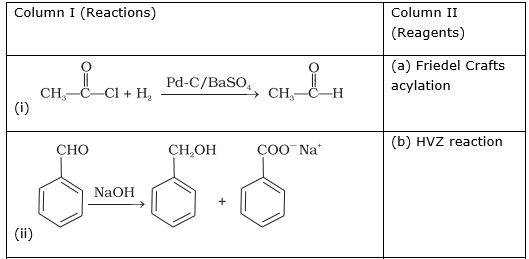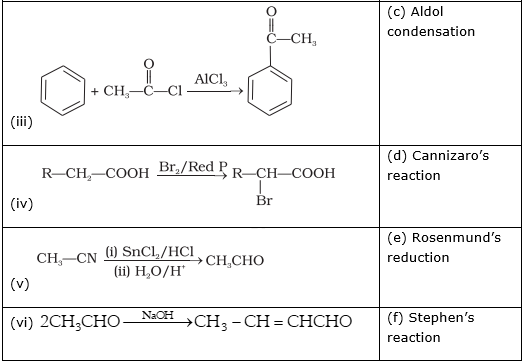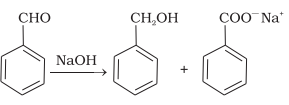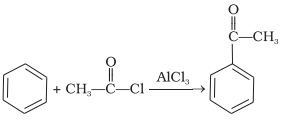Match the example given in Column I with the name of the reaction in Column II.


(i)  → (e) Rosenmund’s reduction
→ (e) Rosenmund’s reduction
(ii)  → (d) Cannizaro’s reaction
→ (d) Cannizaro’s reaction
(iii)  → (a) Friedel Crafts acylation
→ (a) Friedel Crafts acylation
(iv)  → (b) HVZ reaction
→ (b) HVZ reaction
(v)  → (f) Stephen’s reaction
→ (f) Stephen’s reaction
(vi) ![]() → (c) Aldol condensation
→ (c) Aldol condensation
EXPLAINATION:
(i) The given reaction is known as Rosenmund’s reduction.

Acid chloride reacts with Pd-C/ BaSO4 to form the corresponding aldehyde.
(ii) The given reaction is known as Cannizaro’s reaction.

Benzaldehyde undergoes self-oxidation and reduction reaction when heated with concentrated NaOH to form benzyl alcohol and sodium benzoate.
(iii) The given reaction is known as Friedel Crafts acylation reaction.

When benzene is treated with CH3-CO-Cl in presence of anhydrous AlCl3, acetophenone is formed.
(iv) The given reaction is known as the HVZ reaction.

Carboxylic acids having an α-hydrogen when treated with bromine in the presence of small amount of red phosphorus gives bromocarboxylic acids.
(v) The given reaction is known as Stephen’s reaction.

Here, nitriles are reduced to imine and then imine is hydrolyzed to the corresponding aldehyde.
(vi) The given reaction is known as Aldol condensation. Here, ethanol having one α-hydrogen atom undergoes a reaction in the presence of dilute NaOH to form 3-Hydroxybutanal and is further converted to but-2-enal.
